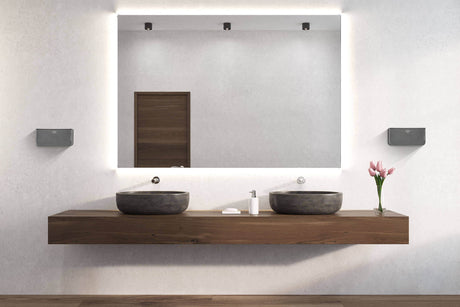Unless you have been living on Mars, you are probably aware that the human race faces a major environmental crisis. It’s an overwhelming thought, but there are plenty of small changes we can make that can cumulatively make a massive difference.
A new year always brings a fresh appetite for change and I was determined to drive down the energy usage in our office and reduce our carbon footprint this year. With all the information online relating to mainly the home, I thought it would be helpful to share my findings to make things quicker for others.
A quick audit of the office revealed we had the following appliances:
- A computer server
- 11 laptops
- 60 x TL-D Strip lights (22 watt)
- A printer/scanner
- A fridge
- A microwave
- A gas boiler
- Electric hand dryer
- Kettle
Last year, we consumed 6800 kw/h in electricity and 2200 kw/h in gas. In the absence of measuring the actual energy use of each appliance, I was able to find out the following information on power consumptions i.e. how much energy each device is consuming each hour.
|
Appliance |
Energy use |
Cost per year |
Percentage of total energy use |
Changes? |
Savings? (per year) |
|
Computer server |
332 kw/hr |
£59.76 |
5% |
Very little that can be done to reduce energy consumption in this area |
n/a |
|
Laptops (x11) |
1007kw/hr |
£181 |
14.8% |
No changes needed |
n/a |
|
TL-D Strip lights (x60) |
4735kw/hr |
£852 |
70% |
We can reduce this by up to 80% using LED lighting - the investment required would be £500 |
£681, with payback in 8 months |
|
Printer/scanner |
39kw/hr |
£7.03 |
0.5% |
To be turned off completely at night |
n/a |
|
Fridge |
130kw/hr |
|
1.9% |
We will be installing a timer on this so it goes off at weekends and it will be turned off over our Xmas break in future |
£7.38 |
|
Microwave |
41.5kw/hr |
£7.08 |
0.6% |
No changes needed |
n/a |
|
Gas boiler |
2200kw/hr |
|
|
|
|
|
Electric hand dryer |
20.42kw/hr |
£3.67 |
0.2% (5% based on a traditional model) |
No changes needed for us but if we had an older model it would represent 5% of our energy use so upgrade |
n/a |
|
Kettle |
33kw/hr |
£5.55 |
0.4% |
We’ve put up a sign to encourage the correct amount of water to be filled which we expect could help to cut up to 25% of this use |
|
1 x Computer server – Dell PowerEdge T110
According to the ITPro review site this product consumes just 38w per hour. The server is on 24/7 but is not a significant percentage of our total energy use.
It is worth noting that website servers are a major source of global emissions, so choose your server provider carefully to see where they acquire their energy from.
The reality is that there is little I could do here to reduce the energy in this area.
However, if you’re still operating with an old server then there are definitely gains and savings to be made. It is said that a server should be replaced/upgraded every 5 years for a small to medium size business.
Older servers consume more power and have less efficient cooling systems. So, if you are looking to upgrade your server, it might be best to consider a more energy efficient version, like the ones specified by Energy Star.
11 x Laptops - Levona B50-5013
Computers are the second largest category for energy use, which isn’t surprising as they are heavily used in our office.
But there are a number of measures that can be used to help reduce the amount of energy these laptops consume:
- Disconnect external devices when not in use – such as webcams, printers, etc
- Adjust your laptop’s energy settings
- Shutdown and unplug your laptop when not in use
- Use a charger only when charging your laptop
60 x lights - 58w 5ft Phillips strip light
What an absolute sin these lights are with 60% of them on 9 hours a day for 252 days a year, costing £852 per annum.
Bingo! 70% of the office’s energy was coming from the lighting. Having spoken with my local electrical wholesaler, we can reduce this by up to 80% using LED lighting, with the investment required being £500. But this would result in a £681 saving with a payback period of 8 months.
A major change that is very much needed.
Samsung Printer - CLX 4195FN
According to the manufacturer the printer draws 300 watts in use, 50 on standby and 2.5 in sleep mode. This is therefore not going to be a huge game changer, especially as we try not to use too much paper. So, at most this would be in use 20 mins a day, with 40 mins on standby and the rest in sleep mode.
However, were wasting energy leaving it on sleep mode at night (35 watts).
This is an Energy Star approved printer and appears to offer reasonable energy efficiency so changing the model wouldn’t make much difference. And it would create unnecessary waste so we will look to keep this going for as long as possible rather than replacing it.
Check to see if your printer is being turned off at night and whether it automatically goes into sleep mode when not in use. Or if you’re looking to replace/upgrade an old printer, consider investing in an energy efficient model.
Fridge
The particular fridge we have is on 24 hours, 365 days a year, based on a temperature setting of 3 degrees. It uses 130 kw/h per year. It seems this is fairly standard.
I will be installing a timer on this so it goes off at weekends, and it will be turned off over our Christmas break in the future. This will also stop people leaving mouldy food in the fridge.
You can take action here and make a slight difference, but remember it’s the slight differences that add up if we all get onboard!
Microwave
An average of 5 meals are heated for 2 mins per day. And so, even though it’s a 1kw appliance, it’s actually only in use for around 10 mins per day.
Again, not a lot of gain to be had in an office of our size by changing or replacing this appliance.
Gas Boiler and heating system
As the boiler provides the heating, it’s all about finding ways of reducing the need for heat. As the energy usage is not that significant, installing a new system was not going to deliver payback. So, we have taken some simple measures to retain and manage the heat instead.
The majority of our radiators are on outside walls so we fitted reflective wall insulation. This apparently saves 70% of the heat lost from the back of the units. We have also bled the radiators and now make sure we keep the doors closed.
Finally, we had been manually operating the thermostat and now we have set it to ensure a constant temperature. We will monitor the effects these changes make over the year.
The gas boiler will need monitoring to understand the actual electrical use required to power the pump.
For larger premises there are obviously far more economical and environmentally friendly systems that need looking into further.
Hand dryers
As we are a hand dryer company, we of course know how much energy these devices use and therefore have a very efficient model already fitted. It is worth noting though that if you currently have hand towels, they will be costing you a small fortune and creating far more emissions for the wider environment due to the production and transportation emissions associated.
If you have a traditional hand dryer you will also be wasting far more energy that you would expect. The average worker during an 8-hour shift goes to the toilet 4.5 times. Our hand dryers use 2 watt/hours per dryer so in our office, with an average of 9 people, the hand dryer uses 20.42 kw/h costing £3.67.
More significantly though, if you have a traditional model it could be guzzling 30 watt/hours per use and therefore 306kw/hours per annum at a cost of £55. If you have hand towels it would reduce your energy bill, but it will be costing over £190 and having a negative impact (85% greater) on the environment.
Kettle
Ah the much-loved brew! In our office, we have 2 cups a day each on average and each time the kettle is used it takes 1 minute to boil. So, the kettle gets boiled around 4 times a day.
We’ve put up a sign to encourage the correct amount of water to be filled, which we expect could help to cut up to 25% of this use, but it’s not a game changer for our individual footprint. That said if we all stopped boiling toomuch water every day, the UK would save 9 million kw/h so it all adds up!
Summary
In order of the biggest savings:
- Lighting – If you have old style lighting, this is by far going to be the biggest saving you can make in an office.
- Hand dryer – the humble hand dryer could be one of your easiest and biggest wins. In our office we were already sorted, but the difference between an inefficient model and an efficient model is far greater than the saving we could make by changing our printer or server.
- Fridge – This doesn’t need to be in use at weekends or the Christmas period, so there are some decent savings to be had here by using a timer and controlling the temperature.
- Heating system – We will have to wait for the savings on gas use. For us, taking basic measures to keep the place warmer without using more energy was logical. We should definitely not be using gas where possible now due to its wider environmental impact.





